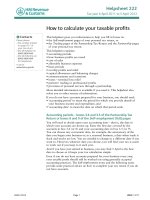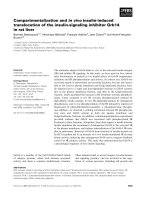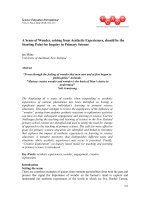The Personal Finance Calculator : How to Calculate the Most Important Financial Decisions in Your Life ppt
Bạn đang xem bản rút gọn của tài liệu. Xem và tải ngay bản đầy đủ của tài liệu tại đây (2.43 MB, 305 trang )
0 (i-xii) front matter 1/31/03 9:31 Page i
Copyright © 2003 by Esme Faerber. All rights reserved. Manufactured in the United States of America.
Except as permitted under the United States Copyright Act of 1976, no part of this publication may be
reproduced or distributed in any form or by any means, or stored in a database or retrieval system, with-
out the prior written permission of the publisher.
0-07-142906-9
The material in this eBook also appears in the print version of this title: 0-07-139390-0
All trademarks are trademarks of their respective owners. Rather than put a trademark symbol after
every occurrence of a trademarked name, we use names in an editorial fashion only, and to the benefit
of the trademark owner, with no intention of infringement of the trademark. Where such designations
appear in this book, they have been printed with initial caps.
McGraw-Hill eBooks are available at special quantity discounts to use as premiums and sales pro-
motions, or for use in corporate training programs. For more information, please contact George
Hoare, Special Sales, at or (212) 904-4069.
TERMS OF USE
This is a copyrighted work and The McGraw-Hill Companies, Inc. (“McGraw-Hill”) and its licensors
reserve all rights in and to the work. Use of this work is subject to these terms. Except as permitted
under the Copyright Act of 1976 and the right to store and retrieve one copy of the work, you may not
decompile, disassemble, reverse engineer, reproduce, modify, create derivative works based upon,
transmit, distribute, disseminate, sell, publish or sublicense the work or any part of it without
McGraw-Hill’s prior consent. You may use the work for your own noncommercial and personal use;
any other use of the work is strictly prohibited. Your right to use the work may be terminated if you
fail to comply with these terms.
THE WORK IS PROVIDED “AS IS”. McGRAW-HILLAND ITS LICENSORS MAKE NO GUAR-
ANTEES OR WARRANTIES AS TO THE ACCURACY, ADEQUACY OR COMPLETENESS OF
OR RESULTS TO BE OBTAINED FROM USING THE WORK, INCLUDING ANY INFORMA-
TION THAT CAN BE ACCESSED THROUGH THE WORK VIA HYPERLINK OR OTHERWISE,
AND EXPRESSLY DISCLAIM ANY WARRANTY, EXPRESS OR IMPLIED, INCLUDING BUT
NOT LIMITED TO IMPLIED WARRANTIES OF MERCHANTABILITY OR FITNESS FOR A
PARTICULAR PURPOSE. McGraw-Hill and its licensors do not warrant or guarantee that the func-
tions contained in the work will meet your requirements or that its operation will be uninterrupted or
error free. Neither McGraw-Hill nor its licensors shall be liable to you or anyone else for any inac-
curacy, error or omission, regardless of cause, in the work or for any damages resulting therefrom.
McGraw-Hill has no responsibility for the content of any information accessed through the work.
Under no circumstances shall McGraw-Hill and/or its licensors be liable for any indirect, incidental,
special, punitive, consequential or similar damages that result from the use of or inability to use the
work, even if any of them has been advised of the possibility of such damages. This limitation of lia-
bility shall apply to any claim or cause whatsoever whether such claim or cause arises in contract, tort
or otherwise.
DOI: 10.1036/0071429069
ebook_copyright 7x9.qxd 7/23/03 10:56 AM Page 1
Contents
ACKNOWLEDGMENTS vii
INTRODUCTION ix
PART ONE
Assessing Your Current Wealth
FINANCIAL CALCULATOR:
#1 How to Determine Your Net Worth 3
#2 How to Determine a Cash Inflows and
Outflows Statement 8
#3 How to Formulate a Budget 12
#4 Time Value of Money and What It Can Do for You 20
#5 Simple Interest and How to Calculate It 22
#6 Compound Interest and How to Determine Future Value 23
#7 What You Need to Know About Nominal Versus Effective
Interest Rates and How to Calculate the Effective Rate 30
#8 Present Value and How to Calculate It 33
#9 Annuities and How to Calculate Them 37
#10 How to Determine the Amounts
Needed to Fund Your Objectives 52
#11 How to Reconcile Your Checking Account 61
#12 How to Prepare Your Records for Your Tax Accountant 68
iii
0 (i-xii) front matter 1/31/03 9:31 Page iii
For more information about this title, click here.
Copyright 2003 by Esme Faerber. Click Here for Terms of Use.
PART TWO
Managing Your Personal Wealth—Debt
FINANCIAL CALCULATOR:
#13 Determine Your Debt Capacity 75
#14 How to Determine the Best Source of Credit 77
#15 How to Determine the Annual
Percentage Rate Costs of Using Credit Loans 81
#16 How to Determine the Rate of
Interest on Your Credit Cards 90
#17 How to Manage Your Debt 94
#18 How Much of a Mortgage Can You Afford? 99
#19 How to Calculate Your Monthly Mortgage Payment 103
#20 How to Determine Your Mortgage Balance 107
#21 Determine Your Mortgage Balance
When Additional Principal Payments Are Made 111
#22 Adjustable Rate Mortgages and How They Work 114
#23 Which Type of Mortgage Should You Choose? 121
#24 When Should You Refinance Your Mortgage? 125
#25 Should You Rent or Buy a House? 127
#26 What You Should Know
About Leasing a Car and How a Lease Works 131
#27 Should You Buy, Lease, or Finance Your Car? 136
#28 How to Create a Simple Interest Loan Schedule 142
iv Contents
0 (i-xii) front matter 1/31/03 9:31 Page iv
PART THREE
Managing Your Personal Wealth—Investments
FINANCIAL CALCULATOR:
#29 Determine Your Investment Objectives 149
#30 Determine Your Risk Tolerance 152
#31 How to Allocate Your Investments 158
#32 How to Determine Your Equity Style in
the Selection of Individual Stocks 165
#33 How to Determine Which Types of
Bonds to Buy for a Portfolio 171
#34 How to Rebalance Your Portfolio 175
#35 The Rule of 72 and How to Use It to Determine
How Long It Will Take to Double Your Money 179
#36 How to Assess and Balance Risk and
Return in the Choice of Different Investments 180
#37 How to Calculate a Simple Rate of Return for
Stocks and Bonds 186
#38 How to Determine a Rate of Return for a Mutual Fund 190
#39 How to Determine the Yield on Treasury Bills 193
#40 How to Determine the Purchase and
Selling Price of Treasury Bills 197
#41 How to Buy and Sell Treasury Securities
Directly from the Federal Reserve 201
#42 How to Convert Municipal Bond Yields to
Before-Tax Yields 207
Contents v
0 (i-xii) front matter 1/31/03 9:31 Page v
#43 Duration and How It Can Help You in
the Choice of Bonds for Your Portfolio 211
#44 How to Value Bonds 217
#45 How to Value Common Stock 220
#46 How to Determine the Growth Rate of a Stock 226
#47 How to Analyze and Evaluate Your Common Stocks 229
#48 How to Choose a Mutual Fund 246
#49 How to Determine the Tax Consequences of
Buying and Selling Shares in a Mutual Fund 254
#50 How to Determine the Average Cost in
Dollar Cost Averaging 259
PART FOUR
Planning for Your Future
FINANCIAL CALCULATOR:
#51 How to Determine Your Future
Financial Needs and How to Fund Them 265
#52 How to Determine How Long Your Money
Will Last in Retirement and the Amount of the
Payment in a Systematic Withdrawal Plan 272
APPENDICES 277
INDEX 287
vi Contents
0 (i-xii) front matter 1/31/03 9:31 Page vi
Acknowledgments
T
he preparation of this book was greatly facilitated by many people at
the McGraw-Hill Publishing Company. Most notably, I am grateful for the
support of Stephen Isaacs and Kelli Christiansen. Rena J. Copperman and Linda
Gorman provided superb editorial assistance and were a pleasure to work with.
I am especially appreciative of their help.
My husband Eric and our children Jennifer and Michael were patient and
supportive, for which I am especially grateful.
vii
0 (i-xii) front matter 1/31/03 9:31 Page vii
Copyright 2003 by Esme Faerber. Click Here for Terms of Use.
This page intentionally left blank.
Introduction
I
have always wanted to write a book that would be different from every
other book on the market. There are no basic money management books
that provide the tools and resources to determine and quantify answers to
personal financial situations and most people’s pressing financial prob-
lems. There are countless personal finance books on the market, but many
do not address how to quantify the specifics of each situation to make the
decisions that will help you achieve your financial objectives and attain finan-
cial freedom. To get answers about a specific issue, you would have to con-
sult a textbook on the subject, which might not be tailored to the problem
facing you. Most people have never had any formal money management edu-
cation, and this holds true for many of the current business graduates from
four-year college and university programs. The Personal Finance Calculator
was written to bridge this gap and provide you with a practical set of tools
you can use not only to solve your financial problems but also to better man-
age your financial affairs.
Financial decisions form the basis of much of what we do in our lives.
Poorly thought out personal finance decisions can at best cause great anxi-
ety and at worst lead to bankruptcy, whereas well thought out, sound finan-
cial decisions can lead to a prosperous lifestyle. Now more than ever, we need
to understand the complexities of our financial circumstances to make sound
decisions. We are confronted by countless financial decisions in our daily lives,
and this book provides a format to assist you in most, if not all, of your
decision-making. Fifty-two different financial calculators provide you with
the opportunity to take charge of your own financial affairs. Each financial
calculator has one or more worksheets with step-by-step instructions to assist
you in determining your answers to each of the financial questions.
ix
0 (i-xii) front matter 1/31/03 9:31 Page ix
Copyright 2003 by Esme Faerber. Click Here for Terms of Use.
The financial tools in this book are arranged into four parts:
1. Assessing your current wealth
2. Managing your debt
3. Managing your investments
4. Planning for your future
Using the financial calculators in each section, you will be able to:
• Determine how much money you have, how much you owe, and
how to better control your finances
• Use the time value of money calculations to make better financial
and investment decisions
• Formulate a plan to manage your debt by using credit wisely
• Figure out how much your debt is costing you and how to choose
the least costly form of financing
• Determine whether you should buy or rent a house
• Determine whether to buy, finance, or lease a car.
• Set investment objectives, make asset allocation plans, and measure
the returns on different investments
• Determine your needs in retirement
The financial tools presented in this book allow you to work through these
and other personal financial problems that you are likely to encounter in man-
aging your personal finances. Most personal finance decisions involve choices,
and making the right choice most of the time involves more than intuition
and guesswork. By working through the different calculations, you will be able
to make informed decisions, which in many cases may save considerable
amounts of money over time. Keep in mind, however, that decision-making
is an ongoing process that will affect your current and future choices.
Each of the financial tools in the four parts can be read and used indi-
vidually, except for those calculations involving the time value of money. Read
the sections on the time value of money, simple interest, compound interest
x Introduction
0 (i-xii) front matter 1/31/03 9:31 Page x
and future value, present values and annuities (sections 4, 5, 6, 8, and 9) first
for an understanding of the subject matter before attempting to use any of
the calculations. Understanding the basis of present and future values is help-
ful in determining the price of a bond. Similarly, understanding annuities can
assist you in the calculation of a monthly mortgage payment and the deter-
mination of a mortgage schedule. There are many software programs and
financial calculators that can assist you in your calculations, obviating the need
to crunch numbers with pen and paper. Reading the text can help you deter-
mine what figures to punch into these programs.
By successfully managing your personal finance decisions, you will man-
age and increase your wealth.
Introduction xi
0 (i-xii) front matter 1/31/03 9:31 Page xi
This page intentionally left blank.
PART ONE
ASSESSING YOUR
CURRENT WEALTH
1 (001-072) part i 1/31/03 9:31 Page 1
Copyright 2003 by Esme Faerber. Click Here for Terms of Use.
This page intentionally left blank.
3
FINANCIAL CALCULATOR #1
How to Determine
Your Net Worth
N
et worth is synonymous with your wealth at a single point in time.
It is the starting point for financial planning and indicates your capac-
ity to achieve your financial goals. Your net worth can be ascertained by draw-
ing up a personal balance sheet, as shown in Worksheet 1.1. The process
consists of three steps:
1. List your assets (items of value that you own).
2. List your liabilities (amounts that you owe to others).
3. Subtract your liabilities from your assets; the difference is your
net worth.
This relationship is shown below:
Items of Value − Amounts Owed = Net Worth
In other words, if you sell all your assets and use the money to pay off
all your debts, what is left over is your net worth.
Assets
Assets are arranged in order of liquidity; that is, the ability to convert them
into cash without losing much in the conversion. The most liquid are at the
top of the list and include cash, checking accounts, money market securi-
ties, and money market mutual funds.
1 (001-072) part i 1/31/03 9:31 Page 3
WORKSHEET 1.1 How to determine your net worth
Assets
Cash $ _______
Checking account balance _______
Savings accounts/money market funds _______
Certificates of deposit _______
Current value of savings bonds _______
Cash surrender value of life insurance _______
Cash surrender value of annuities _______
Market value of investments _______
Mutual funds _______
Stocks _______
Bonds _______
Other _______
Market value of IRA/Keogh
pension/profit sharing/401K _______
Market value of house/real estate _______
Investment property _______
Other _______
Automobile(s) _______
Household furniture/appliances _______
Jewelry/precious metals _______
Collectibles _______
Loan receivables _______
Other _______
Total assets $ _______
Liabilities
Credit card balances $ _______
Bills outstanding _______
Auto loan balances _______
Taxes due _______
Mortgage loans _______
Total liabilities $ _______
Net worth (assets minus liabilities) $ _______
Step 1 List all items of value starting with cash, investment assets, the current value of
your house, and possessions.
Step 2 List and total all liabilities.
Step 3 Subtract total liabilities from total assets.
1 (001-072) part i 1/31/03 9:31 Page 4
Determining the value of your stocks, bonds, and mutual funds is easy.
The prices can be found in the financial pages of a newspaper or obtained
from brokerage and mutual fund statements.
Determining the current value of pension funds may be more difficult
if the pension fund provides amounts of future income to be received. This
means that for this type of plan, you would need to determine the present
value of the plan. The human resources or benefits department of your com-
pany can provide this information.
If the cash surrender values of your whole life insurance policies and
annuities are not shown on the latest statements you receive, call your insur-
ance agent for this information.
Your home is likely to be your largest asset, so its value should not be over-
inflated or underinflated. The figure that you are looking for is the current
market value; that is, what someone would be willing to pay for your house.
Generally, the cost of the property is not particularly relevant if you have
owned your house for a long period of time. The most recent selling prices of
houses similar to yours in your area are a good indicator of the likely mar-
ket value of your house. Real estate brokers can also provide you with an esti-
mate of the value of your house.
The value of cars can be obtained from used car price guides such as the
N.A.D.A. Official Used Car Guide and the Kelley Blue Book (www.kbb.com).
These guides can be found in most public libraries, or you can obtain the price
of your car from your bank, which should have copies of these guides.
Household furniture, clothing, and personal effects should be more con-
servatively valued so as not to overstate their value. In an actual sale of these
items, you might get far less than the estimated values.
Add the estimates of the value of all the items that you own and you
will have the total of your assets.
Liabilities
Begin by listing your most current debts, such as utility bills, telephone bills, and
others. Next, list the balances outstanding on your credit card debts and loans.
Assessing Your Current Wealth 5
1 (001-072) part i 1/31/03 9:31 Page 5
For most people, a home mortgage is their largest single debt outstand-
ing. The amount to include is not the original amount of the loan but the cur-
rent outstanding balance. The reason is because a part of the monthly payments
made to the lender over the duration of the mortgage reduce the outstand-
ing balance of the loan. The current outstanding balance of the loan may be
obtained directly from the lender or from mortgage statements from the lender.
You can also determine the balance yourself. See the financial calculator in sec-
tion 20, which explains how to determine your mortgage balance.
Add up all the amounts owed to others and you have the total of your
liabilities.
Net Worth
Your net worth is the difference between the totals of your assets and liabili-
ties. In other words, if you sold all your assets for the values stated and paid
off all your debts, the amount left over would be your net worth. Your net
worth should not be thought of as cash to be spent. Rather, it is a measure
of a person’s financial position as of the date of the personal balance sheet.
Can your net worth be a negative number? Yes, this is possible. If you have
more debt than total assets, you are technically insolvent. A continuation of
this position may make it difficult for you to pay off all your debts on a timely
basis, which could necessitate a declaration of bankruptcy.
Why Is Determining Net Worth Important?
Determining your net worth is the first step in financial planning and assess-
ing your financial wealth. Net worth changes on a daily basis, so it is not a
good idea to focus on these changes, as net worth is not cash available for use.
Rather, net worth is a yardstick for comparing the changes in your financial
position over a period of time. An increase in net worth over a period of time
is a favorable trend, and a decrease in net worth is a reduction in wealth.
6 THE PERSONAL FINANCE CALCULATOR
1 (001-072) part i 1/31/03 9:31 Page 6
There are a number of ways to increase net worth:
• Appreciation of assets (for example, a rise in the value of stocks,
bonds, mutual funds, and real estate).
• Reducing liabilities. This also reduces the amount of interest pay-
ments made to service the debt.
• Increasing your income, such as through salary and wage increases
and increases in investment income.
• Reducing the amount spent on living expenses.
The importance of increasing net worth is obvious, but the addition of
assets may not always increase your net worth. This is especially true for depre-
ciating assets, such as automobiles, computers, stereo equipment, and the like.
Investment assets could also lose some of their value, as in the stock market
decline of 2000–2002. Paying off liabilities will also increase net worth if assets
remain the same.
Creating a personal balance sheet will assist you in tracking your personal
wealth over time and enable you to see relationships among the balance sheet
items. The relationship between liquid current assets and current liabilities
indicates the relative ease or difficulty in paying upcoming debts. This eval-
uation ratio is the current ratio and is determined as follows:
Current Ratio = Current Assets ÷ Current Liabilities
For example, if a person has $10,000 in liquid current assets and $5,000
in current liabilities, the current ratio is 2. This means that for every $1 in cur-
rent debts, there is $2 in liquid assets. Generally, most current debts are repaid
from liquid current assets such as cash, savings accounts, and money mar-
ket funds. In the event of unemployment or insufficient liquid current assets
to cover current debt, longer-term investment assets would need to be liqui-
dated to pay off the debt.
The other significant relationship between balance sheet items is the debt
ratio, which is total liabilities divided by net worth:
Assessing Your Current Wealth 7
1 (001-072) part i 1/31/03 9:31 Page 7
Debt Ratio = Total Liabilities ÷ Net Worth
For example, if a person has $100,000 in total liabilities and a net worth
of $200,000, the debt ratio is 0.5.
By setting aside more money for savings and investment assets each
month, you will increase your worth. In general, if total current liabilities and
total liabilities are reduced over time, your net worth will also improve and
this will be indicated by a lower debt ratio.
FINANCIAL CALCULATOR #2
How to Determine a
Cash Inflows and
Outflows Statement
O
ne good reason to draw up a cash inflows and outflows statement
is to see where your hard-earned money has gone. Many people com-
plain that they earn large sums of money, but they never have anything left
over. Recording their expenditures is a first step to taking control of their finan-
cial affairs. Because earnings and living expenses also influence net worth, this
statement, also known as an income statement, shows that change. The income
statement shows actual income and expenditures over a period of time,
whereas a balance sheet shows financial position at a single point in time.
There are three easy steps to creating an income statement, as shown in Work-
sheet 2.1.
1. List income received during the time period.
2. List expenditures made during the time period.
3. Determine the surplus/deficit of income over expenditures.
8 THE PERSONAL FINANCE CALCULATOR
1 (001-072) part i 1/31/03 9:31 Page 8
WORKSHEET 2.1 Determine your statement of cash inflows and cash outflows for
the period ____________, ended ____________
Income (cash inflows)
Gross salary/wages _______
Payroll taxes _______
Federal income taxes _______
State income taxes _______
FICA tax _______
Minus total payroll taxes _______
Net salary/wages _______
Interest/dividend income _______
Gain on the sale of stocks/
bonds/investment bonds _______
Tax refund _______
Receipts from pension/
retirement plans _______
Gifts/grants _______
Alimony/child support receipts _______
Other _______
Total income $ _______
Expenditures (cash outflows)
Auto expenses _______
Food _______
Telephone & utilities _______
Medical & dental expenses _______
Entertainment/recreation _______
Donations _______
Gifts _______
Other _______
Rent/mortgage payments _______
Credit card payments _______
Loan payments _______
Insurance premiums _______
House maintenance/repairs _______
Total expenditures $ _______
Cash surplus/deficit $ _______
Step 1 List all sources of income for the period.
Step 2 List all the cash payments made during the period.
Step 3 Subtract expenditures from income. Cash surplus is positive and a deficit negative.
1 (001-072) part i 1/31/03 9:31 Page 9
Step 1: List All Sources of Income
List all sources of income for the period of the income statement (one month,
three months, six months, or one year). Income from wages and salaries is
generally received net of payroll tax withholdings. In other words, taxes are
taken out of your gross income, leaving you with income after taxes. Some
forms of income are paid gross of taxes (in other words, no payroll taxes
are withheld). If these sources of income are large, you would need to esti-
mate the quarterly federal and state tax payments that you need to make.
Quarterly tax payments are made to avoid the possibility of being assessed
penalties for underestimating your federal and state taxes at the end of the
tax year.
The main source of income for most people comes from what is earned from
their occupations in the form of salaries, wages, self-employment income, and
commissions. Other sources of income include bonuses, interest, dividends, rent,
alimony and child support payments, income from Social Security, gains on
the sale of assets, and gifts and inheritances. All sources of income should be
included in order to make the income statement complete and accurate.
Step 2. List All Expenditures
Expenditures show where cash flows have been spent. The types of expendi-
tures to include in the income statement will depend on the complexity of
your financial affairs. Major categories of expenditures should be listed, but
it is not necessary to account for every penny spent. By reviewing check-
book records and credit card statements and performing the more difficult
task of tracing cash payments, you can easily develop categories of expendi-
tures. By adding the payments made in each category, you will have a fairly
accurate account of where your money has gone.
Certain expenditures are fixed; that is, they remain the same each month
or year. Examples are rent, mortgage payments, life insurance premiums, and
child care payments.
10 THE PERSONAL FINANCE CALCULATOR
1 (001-072) part i 1/31/03 9:31 Page 10
Variable expenditures are payments and expenses that change from
month to month, such as food, clothing, medical, dental, gas, and auto
expenses; telephone and utility payments; household operating expenses; con-
tributions; and recreational expenses.
Step 3: Determine Whether There Is a Surplus or
Deficit of Net Cash Flow
When income exceeds expenditures, there is a surplus. When expenditures
exceed income, there is a deficit. Funds to cover a deficit can come from sav-
ings or a loan, both of which decrease net worth. A surplus represents an
increase to net worth if the amount is used to increase savings, acquire addi-
tional assets, and/or pay off debt.
What an Income Statement Can Tell You
The income statement shows whether you have been successful in living
within your income. If the amount saved is negligible or there is a deficit, you
should review where you can make changes to your income and expenditures.
Income is difficult to increase in the short term, although it can be done;
for example, by taking a part-time job. Longer-term income can be increased
by establishing yourself in your profession, finding a better-paying job, or
changing careers. The latter alternative should be deliberated carefully before
any moves are made.
Expenditures are also difficult to reduce, but variable expenditures are
easier to cut than fixed expenditures. For example, it may be easier to reduce
recreation, summer vacation, and/or entertainment expenses than neces-
sary living expenses, such as food, mortgage, auto, and utility expenses.
By going through the process of compiling an income statement, you can
see where money has been spent and where you need to reduce expenditures,
if necessary. The income statement is not only an important tool in helping
to understand current spending patterns, it also assists in formulating a budget.
Assessing Your Current Wealth 11
1 (001-072) part i 1/31/03 9:31 Page 11
FINANCIAL CALCULATOR #3
How to Formulate a Budget
“Cheshire Puss,” Alice began . . . “would you please tell me which way
I ought to go from here?”
“That depends,” said the cat, “on where you want to get to.”
Lewis Carroll, Alice in Wonderland
A
bud get is a plan for how you intend to spend your money during
the coming month, months, or year. It is an integrated statement based
on details of your income statement and balance sheet for the past month,
months, or year and a reflection of your financial goals. It expresses what you
would like to achieve in terms of spending and savings in the future.
A budget can assist you in determining whether:
• You are living within your income limits
• Your current spending patterns are satisfactory
• You are saving and investing sufficient amounts to satisfy your finan-
cial goals
• You need to make changes in order to satisfy your financial goals
A suggested budget format is shown in Worksheet 3.1. You can use this
as a model for your own budget sheets, or you can make several copies to allow
you to project your budget for several months into the future. There are many
personal finance software programs, such as Quicken and Microsoft Money,
that make it easy to compile a budget using your personal computer.
A budget can be drawn up in six easy steps:
1. Estimate your future net income for the period of the budget.
2. Determine your expected expenditures during the period of the
budget.
12 THE PERSONAL FINANCE CALCULATOR
1 (001-072) part i 1/31/03 9:31 Page 12









